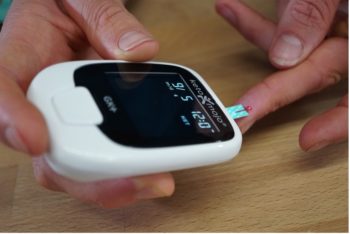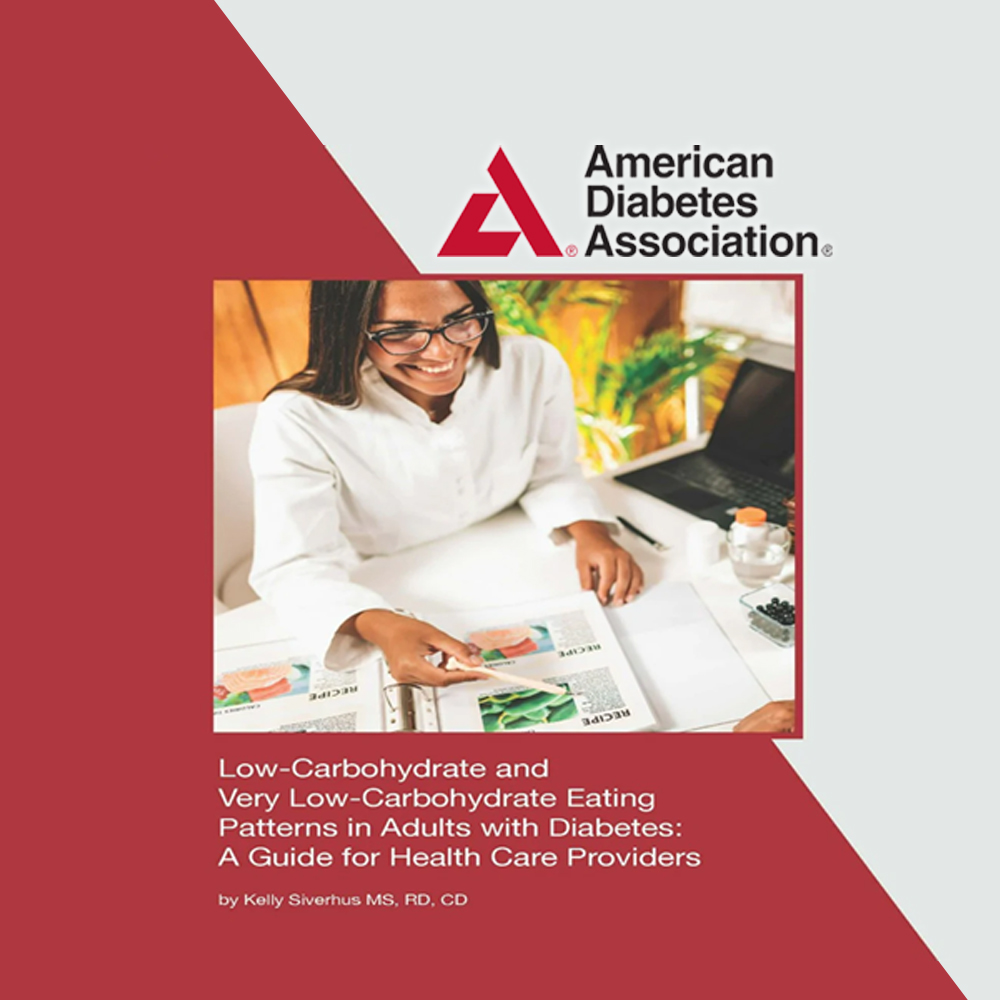The American Diabetes Association (ADA) recently published a guide designed for healthcare practitioners providing options on how to effectively implement low carbohydrate and very low carbohydrate diets for adults with type 2 diabetes. This new guide provides strategies for providers to help determine which eating pattern would be most beneficial for their patient, and ideas for implementing these evidenced-based diet changes.
This guide for healthcare practitioners stems from several position statements from the American Diabetes Association, as well as a consensus report, and Standards of Medical Care in Diabetes publications from 2019 and 2020. All suggest that utilizing a low carbohydrate or ketogenic diet can help reduce HbA1C and reduce medications in persons with type 2 diabetes.
The 2022 ADA Standards of Medical Care publication also states that in individuals with type 2 diabetes who are not meeting glucose targets or require glucose-lowering drugs, low carbohydrate or very low carbohydrate eating plans are a sustainable option. This is a significant change from the previous guidelines, which stated that low carbohydrate diets were not recommended as they eliminated many foods making the diet less palatable, implying that people would have difficulty with compliance to the diet.
This change also comes on the heels of the Mayo Clinic recently recognizing low carbohydrate diets as an alternative for patients with diabetes. The new Mayo Clinic Diet offers meal plans for clients including ‘Healthy Keto meals. This 180-degree shift in thinking about treating diabetes, as well as other comorbidities, is HUGE as it expands the way the medical community thinks about treatment.
The Science Behind Low Carb Diets for Treating Diabetes
Virta Health has been publishing science papers and abstracts demonstrating diabetes reversal and deprescription utilizing a low carbohydrate lifestyle for several years. In their latest abstract, outcomes from their landmark 5-year study have shown evidence that treating type 2 diabetes with a low carbohydrate diet is sustainable and can reverse this condition.
One fifth of the 169 patients in this five-year study experienced full remission of their diabetes, and one-third of patients achieved HbA1c below 6.5% without any diabetes medications, or only requiring Metformin. In addition, there were improvements in weight as well as other biomarkers, such as insulin levels.
From the two-year mark to the five-year mark, they had a 72.2% retention rate, which is incredible. These outcomes of improved glycemic control, weight loss, and retention on a very low carbohydrate diet provide even more validity for this type of eating plan for individuals with type 2 diabetes.
History of Recommended Diet Plans for Diabetics
The creation of this guide is a big step in the right direction by recognizing the benefits of low carbohydrate diets for the reversal of type 2 diabetes. This is a paradigm shift in the way of thinking that nutrition therapy for the treatment of diabetes is a “one size fits all” type of eating plan, as this mentality does not seem to be effective. Nutrition eating plans should be tailored to each specific patient’s goals.
The use of medical nutrition therapy with the plate method, described as half of the plate filled with non-starchy vegetables, one quarter of the plate is protein, and the last quarter is carbohydrate foods, does not seem to be as effective for reversal of diabetes as demonstrated by the continued growth of this condition. In a 2017 randomized controlled trial, the traditional plate method diet was compared with a very low carbohydrate diet. The outcomes showed that patients on the very low carbohydrate diet improved their glycemic control and lost more weight than the plate method group.
The low carbohydrate eating plan is one of the most studied eating plans for type 2 diabetes and has been shown to reduce A1C and reduce diabetic medications. This guide is an excellent starting place for healthcare providers to begin their education regarding this type of eating plan for their patients with type 2 diabetes.
Shortcomings of the ADA Guide
Although the publication of this guide is exciting progress, it is important to note that there are some inconsistencies and sections that need further explanation. It would be ideal for this guide to be reviewed in more detail by additional experts in the low carbohydrate community to provide more clarification for healthcare practitioners preparing to utilize it.
The authors suggest counting total carbohydrates instead of net carbohydrates.
Per the guide, total carbohydrate counting is recommended for maximal weight loss and blood glucose improvement. However, the food lists in the guide should still have fiber listed for patients who choose to count net carbohydrates.
For example, the guide reads that in a half-cup serving, blackberries have 10 grams of total carbohydrates, which would be half of the total days’ worth of carbohydrates for a patient following a very low carbohydrate diet. This could potentially discourage one from choosing blackberries as a food to incorporate into the diet. However, per the USDA half a cup of blackberries has 4.3 grams of net carbs, which would be much more reasonable to incorporate into a diet plan.
The very low carbohydrate non-starchy vegetable list states that all of the foods listed have less than 5 grams of carbohydrates per serving. However, this is not true. They have less than 5 grams of NET carbs but not total. It should be specified more clearly.
Maintaining a total carbohydrate goal of 20 grams of total carbs for 3 to 12 months is extremely difficult for most people to adhere to.
There is concern that adults will not be able to sustain that low level of total carbohydrate intake for such a long period of time, which could potentially lead to the discontinuation of the diet plan. There is also a question as to why such a low level of total carbohydrates is necessary. In a randomized control trial, significant results were achieved for individuals with type 2 diabetes following a diet of 90 grams of total carbohydrates daily. Low carbohydrate options without such strict carbohydrate goals may be more feasible to consider for many individuals, leading to better dietary compliance and results.
The carbohydrate reintroduction phase seems like an old-school Atkins way of practice.
The guide suggests that a patient should add 5 grams of carbohydrates per week until they stop losing weight or start regaining weight. It does not specify if this increase is total carbohydrates or net carbohydrates. Why does weight determine this? What if they have not improved their A1C or deprescribed yet?
Inconsistencies in the types of fats recommended.
The types of fats recommended in the introduction of the guide are appropriate. However, in the food section of the guide, it suggests polyunsaturated fats such as canola oil as well as margarine, which are not generally recommended on a healthy low carbohydrate diet. Some of the information within the guide is inconsistent and therefore could be confusing to individuals new to this type of eating plan.
The guide does not specifically recommend blood ketone testing after the first several days to confirm ketosis.
We know this is important as bioindividuality makes everyone’s ability to get into and stay in ketosis different. Testing ensures you remain in ketosis or provides you with the information to make dietary adjustments. It is important to measure regularly to maintain compliance and it boosts motivation. Urine ketones do not provide the same level of accuracy or reliability as blood ketone measurements. Therefore, blood ketone testing would be especially beneficial for individuals following a low carbohydrate lifestyle, since a person with diabetes will need to adhere to this diet for a long time.

Final Thoughts:
As mentioned, the creation of this guide from the American Diabetes Association is a positive shift in thinking regarding the treatment for the reversal of type 2 diabetes. Virta Health has been studying and practicing this way for years, which has been shown to be significantly beneficial for patient outcomes. There are many clinical studies currently recruiting that support a low carbohydrate eating plan and its impact on type 2 diabetes as well as a variety of other medical conditions. The fact that a major health organization such as the ADA is recognizing the benefits of this type of eating plan is exciting, and we hope there is more to come. It is important to realize how essential medical nutrition therapy is for diabetes management and reversal. The diet should be uniquely tailored to each individual’s needs.
As a registered dietitian in the low carbohydrate space, I find it very promising (albeit a little slow to come) that this professional entity supports a low carbohydrate eating plan to control or reverse diabetes. And I look forward to further research in this area to help those with type 2 diabetes control their blood sugar, decrease medications, decrease weight, and lead a healthier, longer life!



